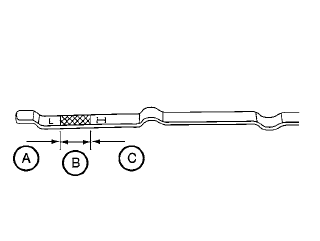Checking engine oil level

1. Park the vehicle on a level surface and apply
the parking brake.
2. Start the engine and let it idle until it reaches
operating temperature.
3. Turn off the engine. Wait more than
10 minutes for the oil to drain back into
the oil pan.
4. Remove the dipstick and wipe it clean. Reinsert
it all the way.

5. Remove the dipstick again and check the oil
level. It should be between the H (High) and
L (Low) marks B . This is the normal operating
oil level range. If the oil level is below
the L (Low) mark A , remove the oil filler cap
and pour recommended oil through the
opening. Do not overfill C .
6. Recheck oil level with the dipstick.
It is normal to add some oil between oil maintenance intervals or during the break-in period, depending on the severity of operating conditions.
CAUTION
Oil level should be checked regularly. Operating the engine with an insufficient amount of oil can damage the engine, and such damage is not covered by warranty.
See also:
Warning and indicator lights
All-Wheel Drive (AWD) warning
light (AWD models)
Anti-lock Braking System
(ABS) warning light
Blind Spot Warning (BSW)
light (orange)
Brake warning light
Charge warning light
Engine oil pressu ...
Moonroof (if so equipped for Hardtop models)
WARNING
• In an
accident you could be thrown
from the vehicle through an open
moonroof. Always use seat belts
and child restraints.
• Do not allow
anyone to stand up or
extend any portio ...
When traveling or registering your vehicle in another country
When planning to drive your NISSAN vehicle
in another country, you should first find
out if the fuel available is suitable for your vehicle’s
engine.
Using fuel with an octane rating that is t ...
